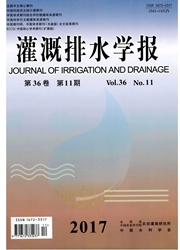

 中文摘要:
中文摘要:
试验采用一种自制装置,在负压入渗原理的基础上,通过设置一系列供水吸力梯度,结合盆栽方式对菠菜的若干生理指标进行研究.结果表明:供水吸力增加,土壤重量含水量逐渐减少;菠菜地上部分鲜重和干重变化趋势一致,先增加后减少,在吸力30hPa时最大;叶片的表观量子产量(AQY)和羧化效率(CE)明显降低;总P和可溶性糖含量逐渐增加,总N含量逐渐减少,总K含量基本没变化;Zn和Mn含量先增加后减小,在吸力100hPa时最大,Fe含量基本不变化,Cu含量变化趋势呈抛物线型,在吸力70hPa时最大.试验中供水吸力在20hPa~40hPa范围内,地上部分生物量较大,微量元素含量较多,营养价值更高,较适合菠菜生长.图2,表1,参14.
 英文摘要:
英文摘要:
The experiment was carried out by using self-design device which can keep the water supply tension negative values. Some parameters of Spinach planted in pots were investigated. The results were as follows: while water supply tension was increased, soil water content was decreased gradually; the fresh and dry weights of shoot were at the same trend and were the maximum at the point of 30hPa, which was increased at the beginning and decreased later; the apparent quantum yield and carboxylation efficiency of Spinach leaves were significantly reduced; the content of P and carbohydrate were increased, the content of N was dropped off gradually, and the content of K was not changed; the contents of Zn and Mn were enhanced at the beginning and then reduced, and the peak was observed under 100hPa, and the content of Fe kept the same, and the content of Cu reached the maximum at 70hPa. The variation trend was a parabola. Higher shoot biomass, more microelements and nutrition were obtained in the range of water supply tension between 20hPa and 4OhPa, showing the best condition for spinach growing.
 同期刊论文项目
同期刊论文项目
 同项目期刊论文
同项目期刊论文
 期刊信息
期刊信息
